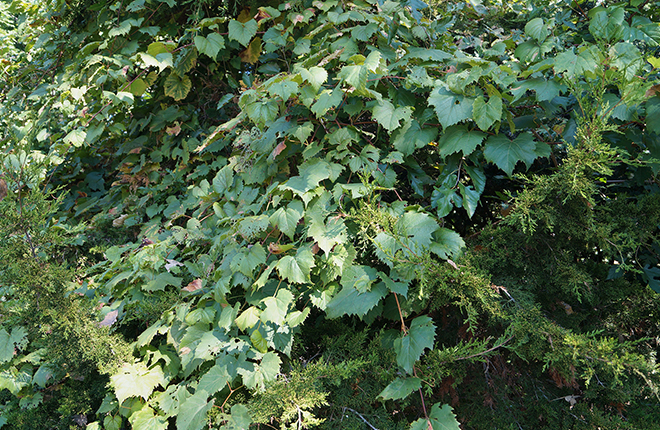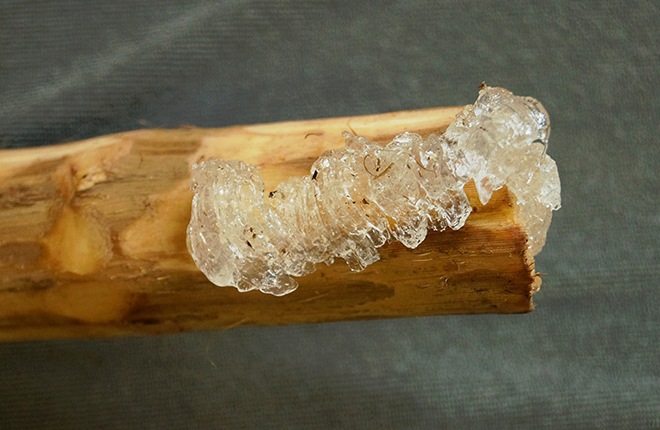Wild Grape: A Domestic Source of Gum Arabic?
If you’re the type of consumer who reads the ingredients listed on the back of a favorite prepared food or beverage, then you’ve probably noticed “gum Arabic” (or “acacia gum”) there. A common thickening agent and emulsifier, gum Arabic is in many products, such as cake frosting, candies and lozenges, paints and inks, postage stamp glue, and cosmetics.
“Gum Arabic is harvested commercially from wild acacia trees throughout the Sahara region of Africa, with more than 80 percent of commercial production centered in Sudan,” says Neil Price, a chemist with the Agricultural Research Service’s National Center for Agricultural Utilization Research (NCAUR) in Peoria, Illinois. However, the gum, which is typically sold in powdered form at a current market price of $3,000 per ton, can be hard to come by. In the mid-1980s, for example, a shortage led to steep price hikes. More recently, there’s been social and political turmoil in the region, among other complicating supply-chain issues.
Domestic equivalents of gum Arabic have proven elusive—until possibly now. Reporting in the August 2015 issue of the Journal of Agricultural and Food Chemistry, Price, together with plant physiologist Steven Vaughn and NCAUR colleagues, announced their discovery of a sap derived from the stem of frost grape, a native U.S. species, that’s both chemically and functionally similar to gum Arabic.
Frost grape, Vitis riparia, occurs throughout North America and typically grows as a woodland vine reaching up to 50 feet in length and measuring 4 to 5 inches in diameter. Indeed, it was shortly after cutting 4-foot sections of the vine on his property in September 2014 that Vaughn first observed the jelly-like sap. Originally, his intent was to burn the vine sections to create a type of soil conditioner called “biochar.” But upon discovering the sap that had oozed out and solidified, he decided to bring some of the sections back to his lab the following week.
Price, whose lab is located a floor below Vaughn’s at the Peoria center, removed the hardened sap and ground it into a powder. He then teamed with chemist Karl Vermillion to analyze the sample using nuclear magnetic resonance spectroscopy. This revealed the sap to be a “polysaccharide,” a type of long-chain carbohydrate whose ratio of two primary sugars—arabinose and galactose—was intriguingly similar to that of gum Arabic. Their interest piqued, the researchers designed a series of experiments to evaluate the polysaccharide’s emulsification, viscosity, gelling point, and other properties.
“It’s strange nobody’s looked at this before,” says Vaughn of the scientific literature review they conducted on frost grape polysaccharide.
“Every day in the lab evaluating it was a ‘wow’ kind of moment,” adds Price.
In experiments using a water solution and grapefruit oil, a common beverage flavoring, adding a 1-percent or less concentration of the polysaccharide produced emulsions (blends of two or more substances that normally cannot be mixed) that remained stable beyond the trial’s 72-hour evaluation period. Fred Eller, a chemist and journal co-author together with Vermillion, subsequently used the polysaccharide to successfully create emulsions of lemongrass and clove oils.
Price is impressed with the frost grape polysaccharide, noting the ease with which it can be extracted and rendered into a white powder, viscous liquid, or clear gel. “It spreads nicely, and you can even paint it onto glass and it won’t streak,” he says. “You can pour it into a tray and pull off a clear film of it after it’s dried.” What’s more, it lacks a protein allergen found in the gum Arabic derived from the acacia tree, and it is free of undesirable terpenoid compounds present in domestic sources of the polysaccharide—notably the western larch tree. Also, unlike corn fiber gum, another potential gum Arabic alternative, the frost grape polysaccharide doesn’t require the use of costly, alkaline-based extraction methods.
Vaughn has screened some locally grown grape varieties, including Concord grapes, to determine if they produce the polysaccharide—or a useful variation thereof. Muscadine grapes are of particular interest because they’re an established native crop with prodigious vine growth.
Price reports that their published paper has already prompted commercial inquiries about the polysaccharide, including its potential as a domestic alternative to imported gum Arabic.
In the meantime, the researchers are trying to nail down the actual function and seasonality of the polysaccharide in the frost grape plant itself. Their best leads come from commercial use of frost grape rootstocks to confer cultivated varieties with resistance to an aphid-like pest, the grape phylloxera. “We think the polysaccharide gums up the insect’s feeding parts, protecting the plant from damage by this pathogen,” says Price.—By Jan Suszkiw, Agricultural Research Service Information Staff.
“Wild Grape: A Domestic Source of Gum Arabic?” was published in the December 2015 issue of AgResearch Magazine.
Key Facts
- Gum Arabic is a widespread food, beverage, and cosmetics ingredient.
- Supply-chain issues have contributed to shortages and price spikes.
- Frost grape polysaccharide is a possible domestic equivalent.
Full Story









